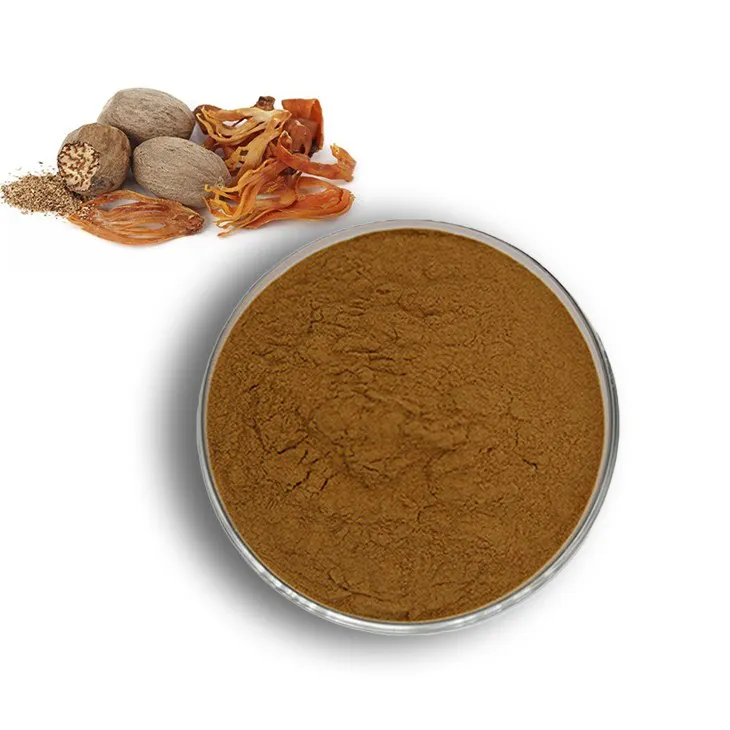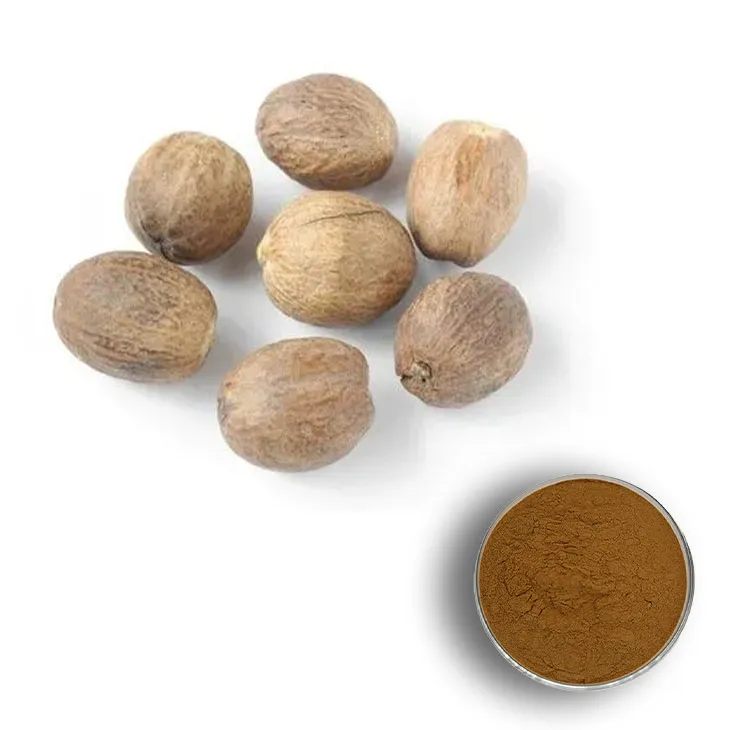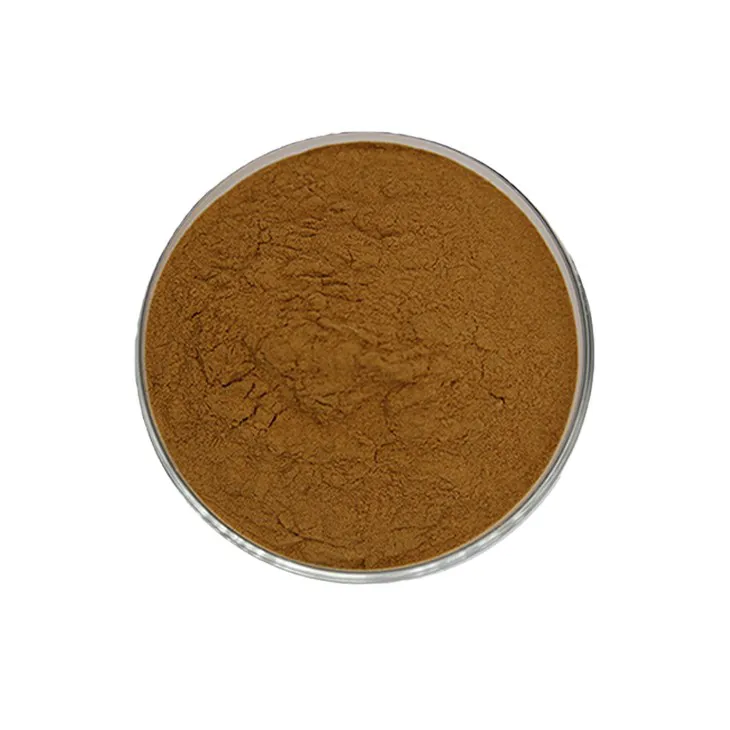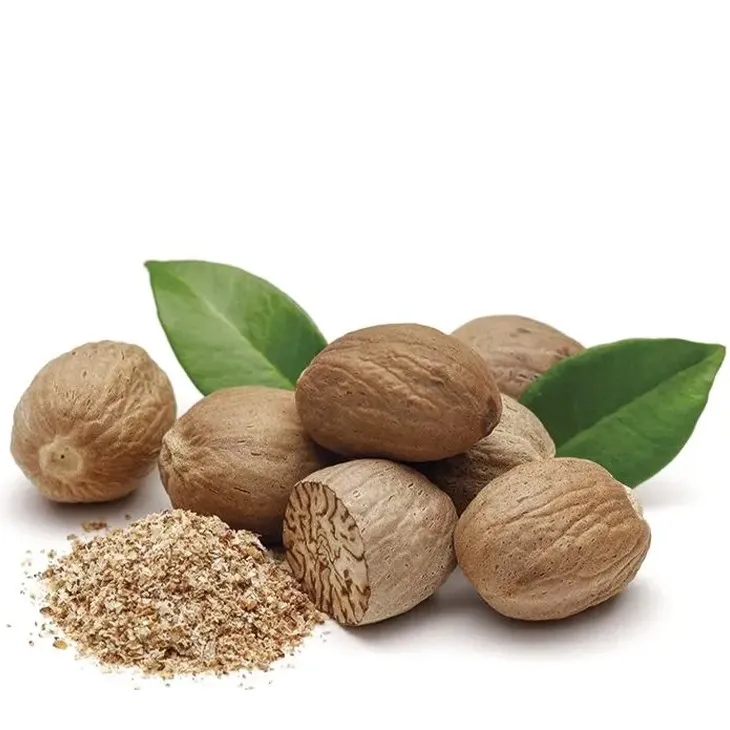- 0086-571-85302990
- sales@greenskybio.com
The flavor of ripe nutmeg and natural nutmeg extract.
2024-11-11

1. Introduction
Nutmeg, a spice with a rich and complex flavor profile, has been prized for centuries in various cultures around the world. The flavor of ripe nutmeg, in particular, is a unique and alluring aspect that is highly sought after in many applications. Natural Nutmeg Extract serves as a concentrated source of this flavor, encapsulating the essence of the ripe nutmeg. This article aims to provide an in - depth exploration of the distinctiveness of the mature nutmeg flavor obtained from natural Nutmeg Extract, covering aspects such as the flavor development during the nutmeg's maturation, the chemical components responsible, and its wide - ranging applications in different fields.

2. The Maturation Process of Nutmeg and Flavor Development
Nutmeg is the seed of the Myristica fragrans tree. The maturation process of nutmeg is a crucial factor in determining its flavor. As the nutmeg fruit develops on the tree, it undergoes several stages of growth.
2.1 Initial Growth Stages
In the early stages, the nutmeg is small and green. At this point, it has a relatively mild and underdeveloped flavor. The chemical compounds within the nutmeg are still in the process of formation, and the characteristic flavor notes are not fully present.
2.2 Ripening Stages
As the nutmeg begins to ripen, significant changes occur. The color of the nutmeg changes from green to a yellowish - brown. This is accompanied by a marked increase in the intensity of its flavor. The essential oils and other flavor - contributing compounds start to accumulate at a higher rate. For example, the levels of myristicin, which is one of the key components responsible for nutmeg's unique flavor, increase during ripening. These changes in chemical composition lead to the development of a more complex and rich flavor profile. The ripe nutmeg has a warm, spicy, and slightly sweet flavor with hints of earthiness and a touch of nuttiness.

3. Chemical Components Responsible for the Ripe Nutmeg Flavor
The unique flavor of ripe nutmeg can be attributed to several key chemical components.
3.1 Myristicin
Myristicin is one of the most important compounds in nutmeg. It is a phenylpropene, which contributes significantly to the overall flavor. Myristicin gives nutmeg its characteristic warm, spicy, and slightly sweet flavor notes. It also has a somewhat narcotic effect in large quantities, which is why nutmeg should be used in moderation in culinary applications.
3.2 Eugenol
Eugenol is another major component. It is also found in other spices such as cloves. Eugenol imparts a spicy, clove - like flavor to nutmeg. In combination with myristicin, it helps to create the complex flavor profile that is characteristic of ripe nutmeg.
3.3 Sabinene
Sabinene is a terpene that is present in nutmeg. It contributes to the overall freshness and spicy - citrusy notes in the flavor of nutmeg. It plays an important role in rounding out the flavor, adding a layer of complexity.

4. Culinary Applications of Ripe Nutmeg Flavor from Natural Nutmeg Extract
The flavor of ripe nutmeg, often in the form of natural nutmeg extract, finds extensive use in the culinary world.
4.1 Baking
In baking, nutmeg is a staple ingredient. It is used in a variety of baked goods such as cakes, cookies, and pies. The warm, spicy flavor of nutmeg complements the sweetness of these items. For example, in a traditional apple pie, a sprinkle of nutmeg or a dash of natural nutmeg extract can enhance the overall flavor, adding depth and a touch of warmth. In cakes, it can be used in the batter or in frosting to give a unique flavor dimension.
4.2 Sauces and Gravies
Nutmeg is also commonly used in making sauces and gravies. It pairs well with cream - based sauces, such as béchamel sauce. A small amount of nutmeg or its extract can add a subtle spiciness and a touch of complexity to the sauce. In gravies, it can help to balance the flavors, especially when used in combination with other spices like black pepper and thyme.
4.3 Meat and Poultry Dishes
In meat and poultry dishes, the flavor of nutmeg can add a unique twist. It can be used in marinades for meats like pork or chicken. The spicy and warm notes of nutmeg can penetrate the meat, enhancing its flavor. When used in slow - cooked dishes such as stews or roasts, it can contribute to a more rounded and complex flavor profile.

5. Perfumery Applications of Ripe Nutmeg Flavor from Natural Nutmeg Extract
The alluring and complex flavor of ripe nutmeg also has applications in the world of perfumery.
5.1 Base Notes
In perfumes, nutmeg can be used as a base note. Its warm, spicy, and slightly sweet undertones can add depth and richness to a fragrance. Base notes are important as they provide the long - lasting foundation of a perfume. Nutmeg's complex chemical composition, with its various flavor - contributing components, allows it to blend well with other base notes such as vanilla, sandalwood, and amber.
5.2 Middle Notes
Nutmeg can also function as a middle note in some perfumes. In this role, it can help to bridge the gap between the top notes (which are usually lighter and more volatile) and the base notes. Its spicy and warm character can add an interesting transition and a touch of mystery to the overall fragrance composition.
6. Traditional Medicine and Nutmeg
Nutmeg has a long history of use in traditional medicine, and the ripe nutmeg's properties are of particular interest.
6.1 Digestive Aid
In some traditional medicine systems, nutmeg has been used as a digestive aid. It is believed to stimulate the digestive system, helping with issues such as indigestion and bloating. The warm and spicy nature of nutmeg may help to increase the production of digestive juices, thus facilitating the digestion process. However, it should be used in moderation as excessive consumption can have adverse effects.
6.2 Anti - Inflammatory Properties
There is some evidence to suggest that nutmeg may possess anti - inflammatory properties. The chemical components in nutmeg, such as myristicin and eugenol, may play a role in reducing inflammation in the body. This has led to its use in traditional remedies for conditions where inflammation is a factor, although more scientific research is needed to fully understand and validate these effects.
7. The Significance of Natural Extraction Methods
Natural extraction methods are of utmost importance when it comes to obtaining the flavor of ripe nutmeg in the form of an extract.
7.1 Preserving the True Flavor
Natural extraction methods, such as steam distillation or cold - press extraction, help to preserve the true flavor of ripe nutmeg. These methods are less likely to introduce artificial or unwanted flavors compared to synthetic extraction methods. For example, steam distillation gently extracts the essential oils from the nutmeg, capturing the delicate balance of the flavor - contributing compounds.
7.2 Chemical Purity and Safety
Natural extraction also ensures a higher level of chemical purity. Since no harsh chemicals are used in the extraction process, the resulting nutmeg extract is more likely to be free from contaminants. This is especially important in applications where the extract is used in food, perfumery, or traditional medicine, as it reduces the risk of potential health hazards.
8. Conclusion
The flavor of ripe nutmeg, sourced from natural nutmeg extract, is a multi - faceted and highly valuable aspect of this spice. From its development during the maturation process, to the chemical components that define it, and its diverse applications in culinary, perfumery, and traditional medicine, ripe nutmeg flavor offers a wealth of possibilities. The significance of natural extraction methods cannot be overstated, as they ensure the preservation of the true flavor and the chemical purity of the extract. As we continue to explore and appreciate the unique qualities of ripe nutmeg, it is clear that it will remain an important ingredient and source of flavor in various industries for years to come.
FAQ:
What are the main chemical components in natural nutmeg extract that contribute to the ripe nutmeg flavor?
Natural nutmeg extract contains several chemical components that contribute to the ripe nutmeg flavor. Myristicin is one of the key compounds. It imparts a warm, spicy, and slightly sweet aroma. Eugenol also plays a role, adding a clove - like, spicy note. Additionally, safrole contributes to the overall complex flavor profile of ripe nutmeg.
How does the flavor of nutmeg change during the maturation process?
During the maturation process of nutmeg, the flavor becomes more complex and intense. Initially, young nutmeg may have a more mild and underdeveloped flavor. As it matures, the levels of the aforementioned chemical components increase. The spiciness becomes more pronounced, and the sweet and warm undertones become more distinct. The overall aroma and flavor develop a depth that is characteristic of ripe nutmeg.
What are the culinary applications of the ripe nutmeg flavor?
Ripe nutmeg flavor is widely used in culinary arts. It is a common ingredient in baking, adding a warm and spicy flavor to cakes, cookies, and pies. In savory dishes, it can be used in creamy sauces for pasta or added to meat dishes like stews and roasts. It also pairs well with dairy products, enhancing the flavor of custards, puddings, and eggnog.
How is natural nutmeg extract used in perfumery?
In perfumery, natural nutmeg extract is used for its warm, spicy, and exotic aroma. It can be a top note, providing an initial burst of spicy freshness. It is often combined with other floral, woody, or citrus notes to create complex and alluring fragrances. It can add depth and warmth to perfumes, making them more inviting and long - lasting.
What are the traditional medicine uses of ripe nutmeg?
In traditional medicine, ripe nutmeg has been used for various purposes. It has been believed to have digestive benefits, helping to relieve indigestion and stomach cramps. It has also been used as a mild sedative, potentially helping with relaxation and sleep. However, it should be noted that nutmeg should be used in moderation in any medicinal context as excessive consumption can be toxic.
Related literature
- The Chemistry of Nutmeg Flavor"
- "Nutmeg: From Tree to Table - A Flavor Profile"
- "Natural Extracts in Perfumery: The Case of Nutmeg"
- "Traditional Medicine and Nutmeg: A Review"
- ▶ Hesperidin
- ▶ Citrus Bioflavonoids
- ▶ Plant Extract
- ▶ lycopene
- ▶ Diosmin
- ▶ Grape seed extract
- ▶ Sea buckthorn Juice Powder
- ▶ Fruit Juice Powder
- ▶ Hops Extract
- ▶ Artichoke Extract
- ▶ Mushroom extract
- ▶ Astaxanthin
- ▶ Green Tea Extract
- ▶ Curcumin
- ▶ Horse Chestnut Extract
- ▶ Other Product
- ▶ Boswellia Serrata Extract
- ▶ Resveratrol
- ▶ Marigold Extract
- ▶ Grape Leaf Extract
- ▶ New Product
- ▶ Aminolevulinic acid
- ▶ Cranberry Extract
- ▶ Red Yeast Rice
- ▶ Red Wine Extract
-
Motherwort Extract
2024-11-11
-
Beta Carotene
2024-11-11
-
Peppermint Oil
2024-11-11
-
Yohimbine Bark Extract
2024-11-11
-
Citrus bioflavonoids
2024-11-11
-
Milk Thistle Extract
2024-11-11
-
Tinospora cordifolia extract
2024-11-11
-
melatonin extract
2024-11-11
-
Propolis Extract Powder
2024-11-11
-
Chia Seed Powder
2024-11-11





















